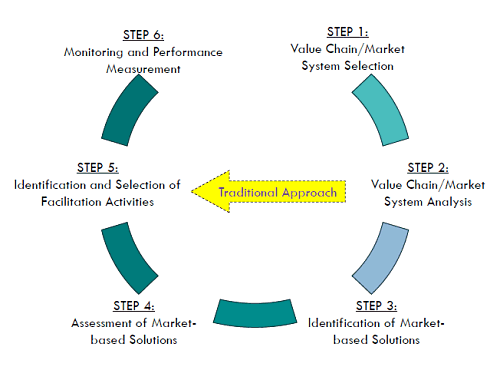
Step 1: Value Chain/Market System Selection
Definition: A value chain can be defined as all the firms that buy and sell from each other in order to supply a particular set of products or services to final consumers. A value chain includes designers, producers, processors, input suppliers, wholesalers, and retailers and is defined by a particular finished product or service (wood furniture, dried tomatoes, clothing production, legal consulting, etc.). [this same definition can be used to describe a "subsector"]
During this step, AFE uses selection criteria to choose promising value chains. These criteria could include:
- Unmet demand in the market for particular products
- Potential for increase in household incomes
- Number of MSMEs in the value chain
- Potential for employment generation
- Existence of linkages conducive to inter-firm collaboration
- Potential for positive coordination and synergy with donors and government
- Representation of women in the value chain
Once criteria are established they are used to compare different value chains. Those that rank the highest are then be chosen for more detailed analysis.
Step 2: Value Chain/Market System Analysis
During this step, AFE carries out interviews and research to gain a greater understanding of market trends and industry dynamics including value chain participants, their roles, and interrelationships. The goal of this step in the approach is to determine key issues hindering MSME growth and competitiveness.
A value chain map is developed that graphically presents all the relevant private sector actors and their relationships with one another. Based on the initial findings of this map, interviews with market-based participants and “key informants”, both large and small, are conducted to identify major constraints and opportunities throughout the value chain. These can be grouped in the following categories:
- technology/product development,
- market access,
- input supply,
- management and organization,
- policy,
- finance, and
- infrastructure
Analysis tools are also used to: 1) understand governance structures within value chains; 2) explore both vertical and horizontal inter-firm cooperation; 3) conduct global benchmarking to compare a targeted country with international competitors.
Value chain analysis can be conducted using different methodologies, including in-depth studies, semi-structured interviews, focus group and stakeholder meetings, and incremental field applications.
Step 3: Identification of Commercially Viable Solutions
During this step, a variety of methods are used to identify and prioritize sustainable, market-based solutions (potential at this point) that can contribute to competitiveness of the targeted value chain and address the constraints and opportunities identified in Step 2.
Step 4: Assessment of Market-based Solutions
During this step, a variety of methods are used to assess the market-based solutions identified in Step 3. Areas of assessment include:
- identification of existing/potential providers of targeted market-based solutions
- challenges to the commercial viability of the targeted solutions
- satisfaction with and awareness of market-based solutions currently provided
- the number of MSMEs that could benefit from the market-based solution
Private sector “lead firms” in the value chain are assessed as to whether they have the requisite incentives and ability to provide needed products and support services to MSMEs in a commercially viable and sustainable manner. Discussions include the provision of "embedded" services by these firms to MSMEs that take place as part of their commercial relationships.
Step 5: Identification and Selection of Facilitation Activities
During this step, the AFE works with market actors to identify program interventions that can support MSME and value chain development. These would include building the capacity of lead firms and others (market-based solution providers) to better address the constraints of their industry and the upgrading needs of MSMEs.
AFE uses focus group discussions with representatives from various actors in the targeted value chain to identify program interventions based on the realities in their industry. This results in the identification and selection of appropriate facilitation activities which will promote sustainable solutions to value chain constraints and enhance the overall competitiveness of participating MSMEs.
Step 6: Monitoring and Performance Measurement
AFE then develops performance measurement systems based on the interventions that have been identified. This system includes indicators for both MSME and industry-wide benefits. It also includes indicators to measure the sustainability of impact.
